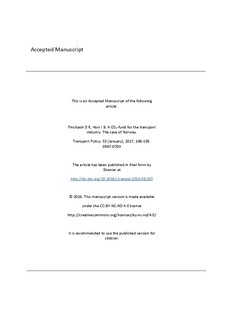| dc.contributor.author | Pinchasik, Daniel Ruben | |
| dc.contributor.author | Hovi, Inger Beate | |
| dc.coverage.spatial | Norway | nb_NO |
| dc.date.accessioned | 2019-07-04T12:52:59Z | |
| dc.date.available | 2019-07-04T12:52:59Z | |
| dc.date.created | 2016-10-27T13:33:19Z | |
| dc.date.issued | 2016-09-02 | |
| dc.identifier.citation | Transport Policy. 2017, 53 (January), 186-195. | nb_NO |
| dc.identifier.issn | 0967-070X | |
| dc.identifier.uri | http://hdl.handle.net/11250/2603434 | |
| dc.description.abstract | Emissions from heavy trucks constitute a large and increasing share of Norwegian CO2-emissions. The Norwegian Green Tax Commission recently presented recommendations for emission reductions, largely confined to ‘sticks’, in the form of taxes and levies. Another way to reduce emissions and to force the phase-in of alternative propulsion systems on heavy trucks, is the use of more positive measures for the industry. In Norway, establishment of a CO2-fund for the industry, modeled after the existing Norwegian NOx-fund, has been proposed. Rather than paying a levy on every litre fuel consumed, participants to the fund will pay a (lower) participation fee in exchange for committing to emission reducing measures. The fund's proceeds will then be used on (partial) subsidies towards the additional investment costs for renewable-based rolling stock and infrastructure. The analysis in this study shows that it is most cost-effective to direct the fund's subsidies towards biodiesel alternatives, but that the availability of sustainable fuel might become a challenge. A fund should therefore also consider subsidizing more expensive renewable technologies based on biogas, electricity, or hydrogen. Although some of these alternative technologies still face several techno-economic barriers, a CO2-fund can contribute to increasing market demand and to achieving critical masses. | nb_NO |
| dc.language.iso | eng | nb_NO |
| dc.publisher | Elsevier | nb_NO |
| dc.rights | Attribution-NonCommercial-NoDerivatives 4.0 Internasjonal | * |
| dc.rights.uri | http://creativecommons.org/licenses/by-nc-nd/4.0/deed.no | * |
| dc.title | A CO2-fund for the transport industry: The case of Norway | nb_NO |
| dc.type | Journal article | nb_NO |
| dc.type | Peer reviewed | nb_NO |
| dc.rights.holder | © 2016 Elsevier Ltd. All rights reserved. | nb_NO |
| dc.description.version | acceptedVersion | nb_NO |
| cristin.unitcode | 7482,3,3,0 | |
| cristin.unitname | Næringslivets transportbehov | |
| cristin.ispublished | true | |
| cristin.fulltext | postprint | |
| cristin.qualitycode | 1 | |
| dc.identifier.doi | 10.1016/j.tranpol.2016.08.007 | |
| dc.identifier.cristin | 1395108 | |
| dc.source.journal | Transport Policy | nb_NO |
| dc.source.volume | 53 | nb_NO |
| dc.source.issue | January | nb_NO |
| dc.source.pagenumber | 186-195 | nb_NO |

